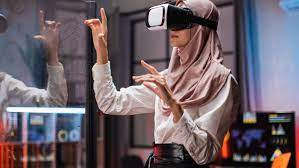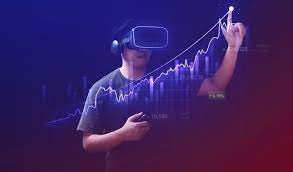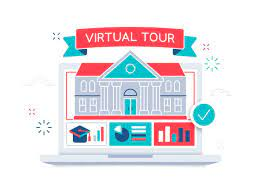Virtual Tour Market
The Virtual Tour Market: Growth, Innovation, and Future Possibilities
Welcome to another Momentum 360 blog! Our goal is to inform you on everything 360 related in our incredible industry. If this is your first time with us, welcome aboard! If you’re coming back for a second read with us, welcome back! In this one, we’ll go over the virtual tour market!

Virtual Tour Market
In a world increasingly dominated by digital experiences, the virtual tour market has emerged as one of the most dynamic sectors. Over the past few years, advancements in technology and shifts in consumer behavior have converged to bring this industry to the forefront. Let’s explore the current landscape of the virtual tour market, its transformative growth, and the horizon of opportunities it presents.
1. Unprecedented Growth Amidst Global Challenges
The year 2020 was a turning point for many industries, with the global pandemic acting as a catalyst for digital adoption. Travel restrictions and safety concerns gave a tremendous boost to the virtual tour sector. What was once a complementary offering became a primary channel for many businesses in real estate, tourism, and education, to name a few. Museums went online, realtors showcased properties virtually, and even remote destinations became accessible with a click.
2. Technological Advancements Fueling Market Expansion
Behind the surge in virtual tours lies a backbone of rapid technological progression:
- 360° Cameras: The affordability and accessibility of 360° cameras have made it easier for businesses to create high-quality virtual tours.
- Augmented Reality (AR) & Virtual Reality (VR): Integration of AR and VR in virtual tours offers immersive experiences. Users aren’t just observers; they are participants, engaging with information pop-ups, interactive elements, and 3D models.
- Cloud Platforms: Cloud-based platforms allow for seamless updates to virtual tours, ensuring real-time accuracy and scalability.
3. Diverse Applications Across Sectors
The appeal of virtual tours is widespread, cutting across various domains:
- Real Estate: Realtors utilize virtual tours to showcase properties, allowing prospective buyers to explore spaces without physical visits.
- Education: Universities and schools have adopted virtual campus tours, aiding decision-making for potential students and their families.
- Museums and Cultural Sites: Virtual tours grant global access to cultural treasures, ensuring art, history, and heritage are accessible to all.
- Retail: Some forward-thinking retailers provide virtual store tours, enhancing online shopping experiences.
4. Benefits Driving Adoption
Several inherent benefits have propelled the growth of the virtual tour market:
- Accessibility: Virtual tours eliminate geographical barriers, making locales, properties, and experiences globally accessible.
- Cost-Efficiency: Businesses save on logistical costs, and consumers can explore multiple options without associated travel expenses.
- Safety: In an era where health and safety are paramount, virtual tours offer risk-free explorations.
- Data Insights: Virtual tour platforms can offer valuable user engagement data, helping businesses understand user behavior and preferences.
5. Future Trends to Watch
As we look ahead, several trends hint at the future trajectory of the virtual tour market:
- Personalized Tours: AI-driven personalization might offer customized tour experiences based on user preferences and past behavior.
- Integration with IoT: Virtual tours might soon be integrated with Internet of Things (IoT) devices, offering a seamless experience across gadgets and smart home systems.
- Social Virtual Tours: Think of virtual tours meeting social media. Users might soon be able to take shared tours, experiencing and commenting on sites with friends or colleagues in real-time.
- Monetization Models: As the market matures, we’ll likely see innovative monetization models, including premium experiences, integrated e-commerce, or subscription-based accesses.
Conclusion: A Revolution in Exploration
The virtual tour market stands as a testament to human adaptability and innovation. What began as a niche offering has expanded into a mainstream industry, redefining how we explore and experience the world around us. Whether it’s a prospective homebuyer in New York exploring a property in San Francisco, a student in Tokyo walking through the halls of a university in London, or an art enthusiast in Buenos Aires marveling at the treasures of the Louvre, virtual tours are bridging gaps and creating connections.

Virtual Tour Market
While the technology will continue to evolve, the essence remains consistent: offering immersive, accessible, and enriching experiences. As businesses, creators, and consumers, the horizon is bright, and the journey is bound to be exciting. The virtual tour market isn’t just about seeing; it’s about experiencing, understanding, and connecting. And the future promises even deeper, more meaningful explorations.
Virtual Tour Market Cap: Analyzing the Financial Landscape
The virtual tour industry has witnessed an explosive growth in the last few years, driven primarily by technological advancements and a shifting consumer landscape. Yet, beyond the surface-level understanding of this growth, there lies the financial dimension. The market capitalization (or market cap) provides insights into the industry’s valuation and offers a lens to evaluate its significance in the larger economic context. This blog will explore the virtual tour market cap, highlighting its current status and future potential.
1. The Surge in Market Cap: A Retrospective
Historically, the virtual tour industry had a relatively modest market cap. This changed dramatically in the wake of global events like the COVID-19 pandemic. As travel restrictions were imposed and businesses sought digital alternatives to physical experiences, there was a surge in demand for virtual tours. Companies operating within this space saw their valuations soar, leading to a substantial increase in the industry’s overall market cap.
2. Leading Players and Their Contribution
Several key players contribute significantly to the virtual tour market cap:
- Matterport: An industry leader, Matterport’s technology has revolutionized 3D virtual tours, particularly in the real estate sector. Their rising stock prices and expanding clientele have made them a significant contributor to the market cap.
- VeeR VR & Kuula: Specializing in 360° virtual tours, these platforms cater to a wide range of industries, from tourism to education. Their consistent growth and market share solidify their position in the industry’s financial landscape.
- Startups and Innovators: A slew of startups are securing funding rounds, pushing valuations and, by extension, increasing the industry’s market cap.
3. Current Valuation vs. Potential Worth
While the current market cap offers a snapshot of the virtual tour industry’s valuation, it’s essential to consider the potential worth. Given the vast applications of virtual tours, from real estate and tourism to education and retail, the industry’s growth potential is immense. As more sectors recognize and adopt virtual tours, the market cap is poised for a steady upward trajectory.
4. Factors Influencing the Market Cap
Several dynamics influence the virtual tour market cap:
- Technological Advancements: The introduction of AR (Augmented Reality) and VR (Virtual Reality) in virtual tours can provide enhanced user experiences, driving demand and increasing valuations.
- Global Events: Events like pandemics or travel restrictions can either inflate or deflate the market cap, depending on their impact on digital adoption.
- Investor Confidence: As with any industry, investor sentiment plays a crucial role. Positive forecasts, successful funding rounds, and robust business models can bolster investor confidence, driving up stock prices and valuations.
- Market Saturation: As the virtual tour industry grows, there’s potential for market saturation. This can lead to competitive pricing, consolidation, or even attrition, impacting the market cap.
5. The Broader Economic Impact
It’s crucial to understand the virtual tour market cap within the broader digital economy. As businesses pivot to online models and consumers increasingly seek digital experiences, industries like virtual tours become significant economic drivers. Their market cap reflects not just their industry-specific growth but also the larger trend of a digital-first economy.
Conclusion: A Future-Ready Industry
Analyzing the virtual tour market cap offers more than just numbers; it provides a narrative. It’s a story of an industry that recognized its potential, adapted to global changes, and is now charting a course for a prosperous future.
However, it’s also a reminder of the fluidity of markets. While the virtual tour industry is currently riding a high, it must continue to innovate, adapt, and offer value to sustain and grow its market cap. Given the tangible benefits and the myriad applications of virtual tours, there’s optimism in the air.
As we keep a pulse on this dynamic industry, the market cap will serve as a barometer of its health, potential, and economic significance. Here’s to the virtual tour industry, an embodiment of innovation and resilience, and its journey ahead in the financial landscape.

Virtual Tour Market
Virtual Tour Market Predictions: A Glimpse into the Future
The virtual tour industry has rapidly evolved in recent years, transforming from a niche luxury to a mainstream necessity. With such dynamic growth patterns and the increasing integration of technology into our daily experiences, where is the virtual tour market headed? Let’s delve into some informed predictions for this burgeoning industry.
**1. Exponential Growth in Real Estate & Hospitality
While real estate has already been an active adopter of virtual tours, we can expect a deeper integration in the coming years. The future might see virtual tours becoming a standard listing feature, not just for luxury properties but across all segments. Similarly, hotels and resorts might offer immersive virtual experiences, letting potential guests “try before they buy.”
**2. Seamless AR and VR Integration
Augmented Reality (AR) and Virtual Reality (VR) are on the brink of reshaping the virtual tour landscape. We can predict that the line between virtual and physical will blur further:
- Virtual Property Customization: Prospective homebuyers could change wall colors, rearrange furniture, or visualize renovations within virtual tours using AR.
- Interactive Tourism: Tourists might be able to undertake VR-powered historical trips, witnessing events or eras of the past come alive.
**3. Rise of the Virtual Shopping Experience
Retailers could embrace virtual tours more robustly. Imagine walking through virtual aisles, picking out products, or even attending virtual fashion shows. This immersive approach can provide a tangible feel to online shopping, making it more experiential.
**4. Educational Institutions to Jump on the Bandwagon
The future might see nearly every university or educational institution offering detailed virtual campus tours. But it won’t stop there. Virtual field trips could become a standard feature of modern education, allowing students to explore historical sites, museums, or even outer space without leaving their classrooms.
**5. Localization and Personalization of Tours
AI-driven personalization will likely play a pivotal role in tailoring virtual tours based on user preferences. For instance, a virtual city tour might highlight culinary spots for a food enthusiast while focusing on historical sites for a history buff. Moreover, tours might be available in a plethora of languages, catering to a global audience.
**6. Healthcare and Virtual Tours
The healthcare industry might leverage virtual tours for patient onboarding. New patients could familiarize themselves with hospital facilities, understand procedures, or even meet the staff virtually. This could be particularly useful for patients who might be anxious about upcoming treatments or surgeries.
**7. Increased Integration with Social Media
Social media platforms could integrate virtual tour functionalities, allowing users to explore vacation spots, restaurants, or event venues shared by friends or influencers. This would blend the experiential component of virtual tours with the social validation that drives modern consumer behavior.

Virtual Tour Market
**8. Eco-friendly Travel Alternatives
As the world becomes more eco-conscious, virtual tours could be promoted as eco-friendly travel alternatives, reducing the carbon footprint associated with tourism. This might appeal to a segment of travelers, especially during times when physical travel might be challenging.
**9. Sophisticated Monetization Models
With increased adoption, businesses will explore innovative monetization strategies. We might witness the rise of subscription-based virtual tour platforms, premium interactive features, or even VR e-commerce integrations within the tour itself.
**10. Enhanced User Interactivity
The future of virtual tours will likely be more interactive. Users won’t just be passive observers but active participants. They might be able to ask questions and receive real-time feedback, touch and feel virtual objects using haptic technology, or even influence the direction of the tour based on real-time choices.
Conclusion: An Uncharted Odyssey Awaits
The realm of virtual tours is brimming with possibilities. As technology continues to push boundaries, industries across the spectrum will recognize and harness the potential of virtual tours, making them an integral part of the consumer experience.
For businesses, the message is clear: adapt or risk obsolescence. And for consumers, a world of immersive experiences awaits, reshaping how we explore, learn, shop, and interact. As we stand on the cusp of this virtual revolution, the horizon promises innovation, engagement, and a redefinition of reality as we know it.
Momentum 360 is a Premiere Small Business and Real Estate marketing company in Philadelphia and tri-state area. Our main service offerings are 3D Virtual Tours powered by Matterport, as well as photography and videography. We are both a Matterport Service Provider and Google Trusted Photography agency. While 3D Virtual Tours started in real estate, they are versatile and applicable across every industry.

Virtual Tour Market
Momentum 360 specializes in virtual tours for real estate, small businesses, restaurants, retail, healthcare, professional services, and much more. These virtual tours help our clients showcase their business online, while also allowing them to rank higher on Google with SEO, and get more followers on social media. Call for a quote.
This article was originally published on momentumvirtualtours
